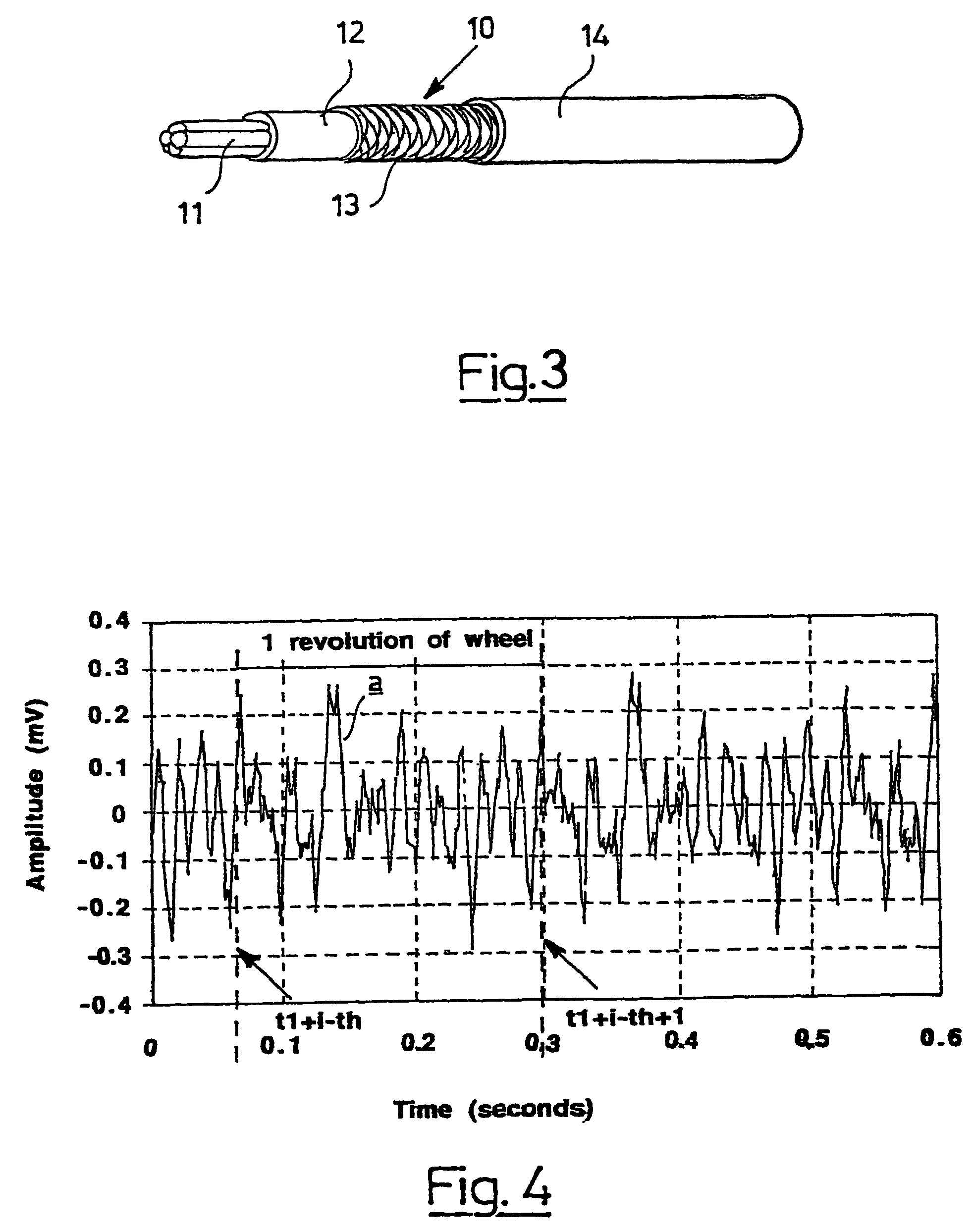Methods for detecting, monitoring, and/or controlling behaviour of a tire in motion
a technology of detecting, monitoring, and controlling the behaviour of tires, which is applied in vehicle tyre testing, instruments, roads, etc., can solve the problems of not allowing significant information to be extracted on the state of mechanical stress comparison between signals supplied at two successive moments does not in itself yield any useful information on the state of deformation of the complete tyre and of the vehicle's behaviour
- Summary
- Abstract
- Description
- Claims
- Application Information
AI Technical Summary
Benefits of technology
Problems solved by technology
Method used
Image
Examples
example 1
Index Representative of the Road Condition
[0325]The description of this type of event involves continuous monitoring of the surface characteristics of the ground over which the vehicle is moving, by identifying the presence of macroscopic irregularities, such as potholes, undulations, breaks in the road surface, and so forth.
[0326]The index representing the condition of the road was calculated by:[0327]acquiring the signal emitted by a sensor in accordance with the invention in a 6-second time interval and by a sampling rate (i.e. detecting the instantaneous value of the signal) of 3000 points per second,[0328]performing an FFT analysis on the acquired signal to determine the corresponding spectrum of frequencies;[0329]confining this spectrum to the range of frequencies lying between 0 and 70 Hz,[0330]performing the RMS calculation within the abovementioned range of frequencies.
[0331]As indicated, the result of this calculation is a numerical value (or index) which can be put throug...
example 2
Index Representing the Efficiency / Regulation of the Dampers of a Vehicle
[0335]The signal sent by a sensor according to the present invention may contain anomalous frequencies identifiable as frequencies of resonance of the vehicle suspensions excited by a rough road surface.
[0336]Under normal conditions the vibrations of the suspensions are damped by the dampers and are therefore of limited magnitude.
[0337]However, in the event of malfunction of the dampers, as when they are discharged, the suspensions vibrate at their own resonant frequencies in a way dissimilar to their normal operation.
[0338]The signal emitted by the sensor is modified in consequence and these vibrations are easily detectable from spectrographic analysis of the said signal.
[0339]The corresponding index is calculated by:[0340]acquiring the signal emitted by the sensor over a 6-second time interval at a sampling rate of 3000 points per second,[0341]performing FFT analysis on the acquired signal to determine the cor...
example 3
Index Representing the State of Instantaneous Stress of a Tyre
[0345]As already indicated and explained above, the signal obtained from a sensor according to the invention can also be used to objectively analyse the interaction between the tyre and the contact surface and indicate the state of mechanical stress of the tyre (both instantaneous and progressive) as it moves over the said surface.
[0346]In other words the signal obtained from the sensor can be used to monitor the structural integrity of the tyre.
[0347]The progressive state of stress of the tyre, meaning the history of the stresses to which the tyre has been subjected over time, can be used to quantify the total fatigue of the tyre in order to predict its residual life.
[0348]The index representing the state of stress of the tyre was calculated by:[0349]continually acquiring (every second) the signal emitted by the sensor over the time interval of 1 second at a sampling rate of 5000 points per second,[0350]performing an FFT...
PUM
 Login to View More
Login to View More Abstract
Description
Claims
Application Information
 Login to View More
Login to View More - R&D
- Intellectual Property
- Life Sciences
- Materials
- Tech Scout
- Unparalleled Data Quality
- Higher Quality Content
- 60% Fewer Hallucinations
Browse by: Latest US Patents, China's latest patents, Technical Efficacy Thesaurus, Application Domain, Technology Topic, Popular Technical Reports.
© 2025 PatSnap. All rights reserved.Legal|Privacy policy|Modern Slavery Act Transparency Statement|Sitemap|About US| Contact US: help@patsnap.com



